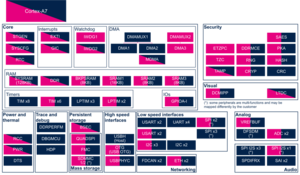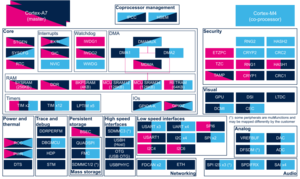1. Article purpose[edit | edit source]
The purpose of this article is to:
- Briefly introduce the RNG peripheral and its main features.
- List the software frameworks and drivers managing the peripheral.
- Explain how to configure the peripheral.
2. Peripheral overview[edit | edit source]
The RNG peripheral is used to provide 32-bit random numbers.
Refer to the STM32 MPU reference manuals for the complete list of features, and to the software frameworks and drivers, introduced below, to see which features are implemented.
3. Peripheral usage[edit | edit source]
This chapter is applicable in the scope of the OpenSTLinux BSP running on the Arm® Cortex®-A processor, and the STM32CubeMPU Package running on the Arm® Cortex®-M processor.
Refer to the wiki article Hardware random overview to learn more on the possible usages of this peripheral.
3.1. Boot time assignment[edit | edit source]
3.1.1. On STM32MP13x lines  [edit | edit source]
[edit | edit source]
Click on ![]() to expand or collapse the legend...
to expand or collapse the legend...
| Domain | Peripheral | Boot time allocation | Comment | |||
|---|---|---|---|---|---|---|
| Instance | Cortex-A7 secure (ROM code) |
Cortex-A7 secure (TF-A BL2) |
Cortex-A7 non-secure (U-Boot) | |||
| Security | RNG | RNG | ✓ | ☑ | ☐ | Required for DPA peripheral protection |
3.1.2. On STM32MP15x lines  [edit | edit source]
[edit | edit source]
Click on ![]() to expand or collapse the legend...
to expand or collapse the legend...
| Domain | Peripheral | Boot time allocation | Comment | |||
|---|---|---|---|---|---|---|
| Instance | Cortex-A7 secure (ROM code) |
Cortex-A7 secure (TF-A BL2) |
Cortex-A7 non-secure (U-Boot) | |||
| Security | RNG | RNG1 | ☑ | ☐ | ||
3.1.3. On STM32MP2 series[edit | edit source]
Click on ![]() to expand or collapse the legend...
to expand or collapse the legend...
| Domain | Peripheral | Boot time allocation | Comment | |||
|---|---|---|---|---|---|---|
| Instance | Cortex-A35 secure (ROM code) |
Cortex-A35 secure (TF-A BL2) |
Cortex-A35 non-secure (U-Boot) | |||
| Security | RNG | RNG | ✓ | ☑ | ☐ | |
3.2. Runtime assignment[edit | edit source]
If the Arm® Cortex®-A processor hardware RNG peripheral is assigned to OP-TEE, then the Linux kernel can request random numbers through the hardware random framework, which is interfaced with the OP-TEE RNG Linux driver .
If the Arm® Cortex®-A processor hardware RNG peripheral is assigned to the Linux kernel, then the Linux kernel can access it through the hardware random framework, which is interfaced with the Linux RNG driver .
3.2.1. On STM32MP13x lines  [edit | edit source]
[edit | edit source]
Click on ![]() to expand or collapse the legend...
to expand or collapse the legend...
| Domain | Peripheral | Runtime allocation | Comment | ||
|---|---|---|---|---|---|
| Instance | Cortex-A7 secure (OP-TEE) |
Cortex-A7 non-secure (Linux) | |||
| Security | RNG | RNG | ☐ | ☐ | Assignment (single choice) |
3.2.2. On STM32MP15x lines  [edit | edit source]
[edit | edit source]
Click on ![]() to expand or collapse the legend...
to expand or collapse the legend...
| Domain | Peripheral | Runtime allocation | Comment | |||
|---|---|---|---|---|---|---|
| Instance | Cortex-A7 secure (OP-TEE) |
Cortex-A7 non-secure (Linux) |
Cortex-M4 (STM32Cube) | |||
| Security | RNG | RNG1 | ☐ | ☐ | Assignment (single choice) | |
| RNG2 | ☐ | |||||
3.2.3. On STM32MP25x lines  [edit | edit source]
[edit | edit source]
Click on ![]() to expand or collapse the legend...
to expand or collapse the legend...
| Domain | Peripheral | Runtime allocation | Comment | |||||
|---|---|---|---|---|---|---|---|---|
| Instance | Cortex-A35 secure (OP-TEE / TF-A BL31) |
Cortex-A35 non-secure (Linux) |
Cortex-M33 secure (TF-M) |
Cortex-M33 non-secure (STM32Cube) |
Cortex-M0+ (STM32Cube) | |||
| Security | RNG | RNG | ☑OP-TEE | ☐ | ☐ | ⬚ | ||
4. Software frameworks and drivers[edit | edit source]
Below are listed the software frameworks and drivers managing the RNG peripheral for the embedded software components listed in the above tables.
- Linux®: hardware random framework, Linux RNG driver , and OP-TEE RNG Linux driver when random number generation is managed by OP-TEE (default behavior)
- U-Boot: U-Boot RNG driver and OP-TEE RNG U-Boot driver
- OP-TEE: OP-TEE RNG driver and RNG PTA
- STM32Cube: RNG HAL driver and header file of RNG HAL module
5. How to assign and configure the peripheral[edit | edit source]
The peripheral assignment can be done via the STM32CubeMX graphical tool (and manually completed if needed).
This tool also helps to configure the peripheral:
- Partial device trees (pin control and clock tree) generation for the OpenSTLinux software components.
- HAL initialization code generation for the STM32CubeMPU Package.
The configuration is applied by the firmware running in the context in which the peripheral is assigned.
This configuration is done in OP-TEE through the device tree.
For more information, refer to the wiki article RNG device tree configuration.
6. References[edit | edit source]

